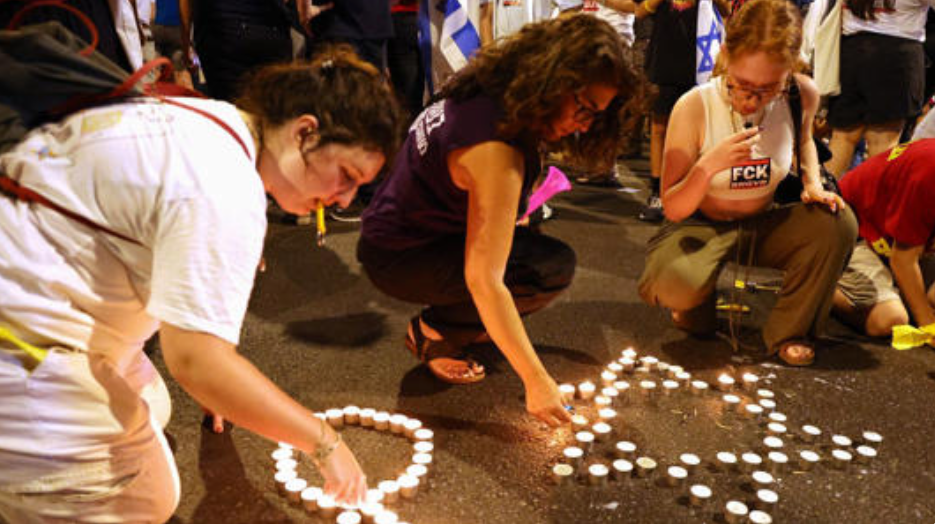One of the main questions raised during a meeting President Biden and Vice President Harris had with their national security team on Monday was whether there is a hostage-release and ceasefire in Gaza deal Hamas would ever agree to, U.S. officials said.
Why it matters: Biden and his top advisers were shocked after Hamas killed six hostages, among them U.S. citizen Hersh Goldberg-Polin, and have started to rethink the way forward in the negotiations over the deal.
- At the same time, Hamas’ new demand to increase the number of Palestinian prisoners released as part of the deal raised even more concerns and questions among U.S. negotiators about whether an agreement is possible, U.S. officials said.
- “We still think the deal is the only way to save the lives of the hostages and stop the war. But the executions not only increased our sense of urgency but also called into question Hamas’ willingness to do a deal of any kind,” a U.S. official said.
Behind the scenes: U.S. officials said one of the main arguments made in the meeting was that after Hamas murdered the hostages, including an American, the U.S. shouldn’t push for a proposal that gives Hamas additional concessions and instead focus on applying more pressure and accountability measures against Hamas.
- A concern raised in the situation room meeting was that the U.S. could press Israel to reduce Israel Defense Forces deployed along the Egypt-Gaza border or on other issues, only to discover that Hamas doesn’t agree to other parts of the deal. That could mean the new offer would only become the foundation for future negotiations that would be more favorable to Hamas, a U.S. official said.
- During the situation room meeting, Biden was briefed about the Department of Justice plan to publish indictments against Hamas leaders, which have been sealed since February, one U.S. official said.
- On Wednesday, Hamas officials continued to stress that the U.S., Qatar and Egypt need to pressure Israel to agree to its demands.
Driving the news: White House National Security Adviser Jake Sullivan told the families of the U.S. hostages on Sunday that Biden is considering presenting an updated and final proposal for the hostage-release and ceasefire deal this week and asking Israel and Hamas to respond.
- But in recent days, the White House appears to be less enthusiastic about that option. Biden’s advisers are still holding talks with Qatar and Egypt on the updated proposal but U.S. officials say they don’t want to predict the timeline for presenting it.
- “The text is basically done except for two paragraphs and the annexes of the prisoner exchange and two maps of IDF deployment in Gaza during the first phase of the deal,” a U.S. official said.
- “We all feel the urgency but what happened last weekend changed the character of the discussion. But we do want to try and get something together,” the U.S. official said.
State of play: A U.S. official said the two main sticking points are the issue of control over the Philadelphi corridor along the Egypt-Gaza border and the number and identity of the Palestinian prisoners who Hamas wants to be released during the first phase of the deal.
- The U.S. official said that while the focus in recent weeks was on the Philadelphi corridor, the prisoner issue is proving just as difficult to resolve.
- U.S. and Israeli officials said that during the negotiations in Doha last week Hamas backtracked from its own previous positions and demanded to increase the number of prisoners to be released. Many of the prisoners are serving life sentences in Israeli prisons for murdering Israelis.
- In previous rounds of negotiations there was an understanding that in the first phase of the deal, 150 Palestinian prisoners who are serving life sentences would be released. Now Hamas demands a higher number, the officials said.
- “We had a very frustrating process around that in Doha last week. Hamas presented demands that were different from what was agreed on in the past,” a U.S. official said.
-
- The draft deal says IDF forces need to redeploy out of densely populated areas of Gaza during the first phase of the agreement. The U.S. official said the argument is which areas of the 14-kilometer-long road along the border between Egypt and Gaza are considered densely populated.
- The official said the U.S. thinks the map Israel presented is in line with the principles of the deal because it included significant reduction in the number of troops and deployment outside of densely populated areas.
- At the same time, the official suggested Israel can make further “adjustments” on the IDF deployment in the area in order to allow a deal to be reached.
- “The Philadelphi corridor has become political issue … I saw some of the Israeli ministers claimed the deal endangers Israel’s security. It’s not true. Not taking the deal is a bigger danger for Israel’s security than taking the deal, including when it comes to Philadelphi,” the U.S. official said.
Yes, but: U.S. officials say they think that even if the Philadelphi corridor issue is somehow resolved, Hamas will still then insist on releasing more prisoners.
